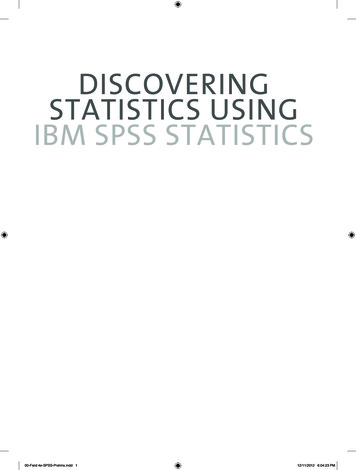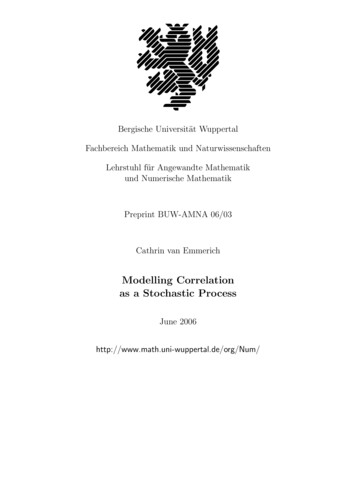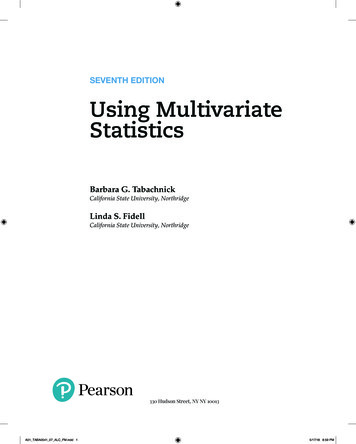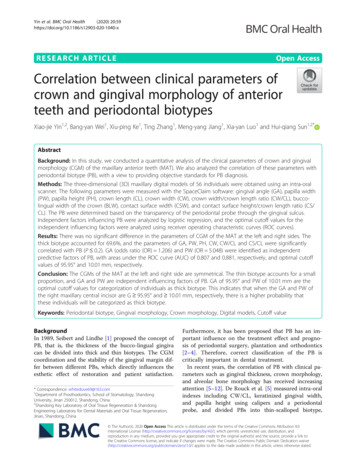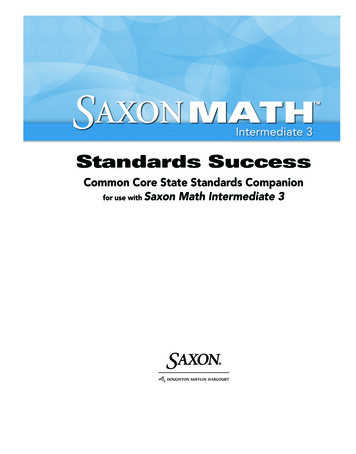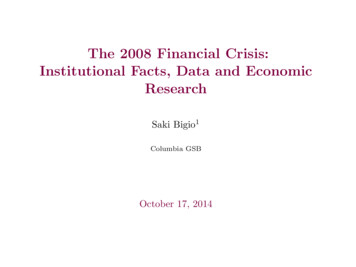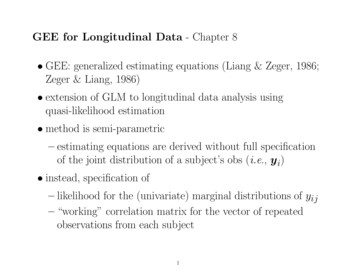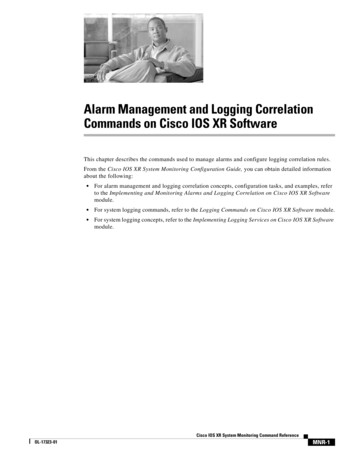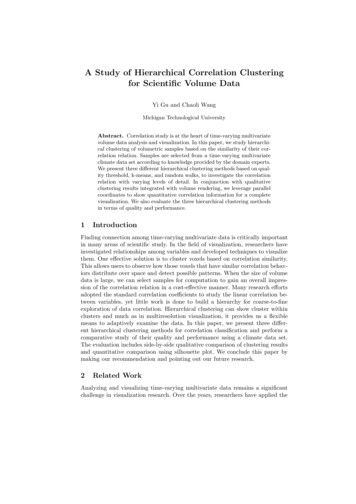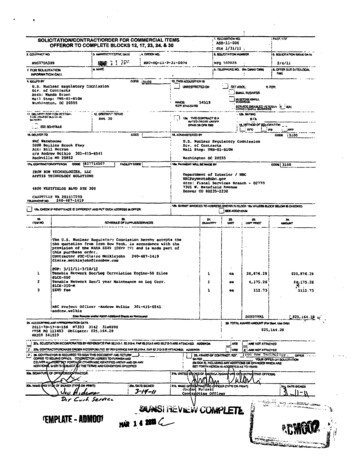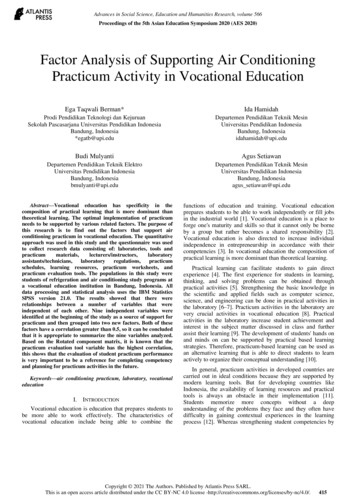
Transcription
A Correlation ofFoundations ofRestaurant Management & Culinary Arts,Second EditionLevel 2 2018To theHawaii Department of EducationCareer and Technical EducationCareer Pathway: Public and Human ServicesCulinary I
A Correlation of Foundations of Restaurant Management & Culinary Arts,Second Edition, Level 2 2018INTRODUCTIONThis document demonstrates how well The National Restaurant Association’s Foundations of RestaurantManagement & Culinary Arts, Second Edition, Level 2 2018 meets the Hawaii Department of EducationPublic and Human Services CTE Career Pathway standards for Culinary I (last modified October 31, 2012). Thestandards listed herein consist of specific competencies and skills established by the American CulinaryFederation (ACF) as represented by NOCTI in its 2013 assessment blueprint for ACF culinary arts certification,which can be found online at http://www.nocti.org/PDFs/ACF/3990%20and%203991 Culinary Arts.pdf.Correlation page references are to the Student Edition, and are cited at the page level.The National Restaurant Association created the most comprehensive curriculum developed by industry andacademic experts, Foundations of Restaurant Management & Culinary Arts, Second Edition. This two-levelprogram provides comprehensive student resources and robust teacher materials to provide an in-depth,industry-driven learning experience. Each Level features blended coverage of culinary arts and management topics designed to buildwell-rounded skills for the workplace. 21st Century Learning objectives are taught and reinforced throughout the program; critical thinkingand problem solving; communication and collaboration; creativity and innovation; global awareness;and health literacy. Curriculum of the ProStart ProgramCertificationStudents can earn exclusive certificates from the National Restaurant Association that meet Carl Perkins fundingrequirements. Upon completion of each course, Levels 1 and 2, students are eligible to take the correspondingexam. Those that pass will receive a certificate of recognition from the National Restaurant Association.SE Student Edition2
A Correlation of Foundations of Restaurant Management & Culinary Arts,Second Edition, Level 2 2018StandardConceptBenchmarkPLC 1.0Assess the impactof the interrelationshipbetween theculinary andhospitalityindustries tocapitalize onsustainable andgrowthopportunities.Culinary &HospitalityIndustriesPLC 1.1Compare and contrast the impact of the culinary andhospitality industries for their role in the community. Define the role of the culinary industry in thelocal and tourist community.HawaiianCulture ValuesPLC 2.0Analyze theimpact of changesin foodproduction andconsumption onthe evolution ofthe culinaryindustry.FoodProductionFoundations of RestaurantManagement & Culinary Arts,Second Edition, Level 2 2018SE: n/a Define the role of the hospitality industry in thelocal and tourist community.SE: n/a Analyze the impact of the inter-relationship ofthe culinary and hospitality industries insustaining and growing opportunities in thelocal and tourist community.SE: n/aPLC 1.2Analyze the impact of “Hawaiian Culture Values” forsustaining and growing the culinary and hospitalityindustry such as§ Spirit of Aloha§ Spirit of ‘ohana§ Ho’okipa (hosting)§ Local cuisinesPLC 2.1Analyze the impact of food production changes on theavailability of food sources in the culinary industry. Analyze major changes in food production fortheir impact on the culinary industry.o Examine the evolution of growing andharvesting practices on crops, fish andanimal food sources for their impact onthe culinary industry.o Examine the impact of technologicalchanges on the availability of food sourcesfor the culinary industry.§ Cooling food (Refrigeration,freezing, flash freezing)§ Preservation of food (canning,packaging, food additives)§ Transportation of food (ground,air, shipping)SE: n/aSE: 59 (did you know), 62(nutrition), 129, 318–322, 372–374SE: 230, 261, 275–277PLC 2.2Compare and contrast various culinary relatedindustries for their role in food production.SE Student Edition Describe the role of the food research anddevelopment industry on food production.SE: n/a Examine the impact of the food manufacturingindustry on food production.SE: n/a Examine the role of the food safety industry onfood production.SE: 48, 52, 59, 384–385, 406–407,424–4253
A Correlation of Foundations of Restaurant Management & Culinary Arts,Second Edition, Level 2 2018StandardConceptBenchmarkPLC 2.0, cont.Contributorsto theIndustryPLC 2.3Analyze the impact of major culinary innovators,institutions and innovations that have revolutionizedthe culinary industry internationally, nationally, andlocally.Foundations of RestaurantManagement & Culinary Arts,Second Edition, Level 2 2018SE: n/a Analyze the impact of culinary innovators thathave revolutionized the culinary industry such as§ Boulanger’s Restaurant§ Auguste Escoffier§ Julia Childs§ Various Hawaii ChefsFoodConsumptionPLC 3.0Evaluate personalinterests andstrengths forcompatibility withthe skills andattitudes essentialto varied culinarysettings.SE Student EditionFood ServiceSettings Analyze the impact of culinary institutions thathave revolutionized the culinary industry suchas§ Le Cordon Bleu§ The Culinary Institute of America§ Culinary Institute of the PacificSE: 204 Analyze the impact of culinary innovations thathave revolutionized the culinary industry suchas§ Media cooking and food shows§ Food movements (e.g., fusioncooking, farm to table, slow food,pop-up restaurants)SE: 131, 259, 316–332PLC 2.4Analyze the inter-relationship of changing foodconsumption patterns and consumer demand for theirimpact on the culinary industry. Analyze changes that impact food consumptionpatterns such as lifestyle choices, healthrelated preferences, food trends, and foodcost.SE: 181 (industry), 366–374 Analyze the impact of exposure to globalcuisines, seasonings and flavors on consumerdemand and the culinary industry.SE: n/aPLC 3.1Compare and contrast where and how food is servedimpacts the purpose, presentation, service, andcooking techniques. Compare and contrast food service commercialfacilities for their purpose, presentation,service, and cooking techniques such as§ Fine dining§ Family dining§ Fast foodSE: 28–294
A Correlation of Foundations of Restaurant Management & Culinary Arts,Second Edition, Level 2 2018 Compare and contrast food service institutionalfacilities for their purpose, presentation,service and cooking techniques such as§ Hospitals§ Schools§ Military§ Religious OrganizationsStandardConceptBenchmarkPLC 3.0, cont.OccupationCompatibilityPLC 3.2Compare and contrast the modern brigade and nonbrigade systems in the food service facilities todetermine the skills and knowledge needed forcompatibility with personal interests and strengths.Professionalism:Work AttitudeBehaviorProfessionalGrowthSE: n/aFoundations of RestaurantManagement & Culinary Arts,Second Edition, Level 2 2018 Analyze skills and knowledge needed in amodern brigade system to determinecompatibility with personal interests, values,goals, and strengths.§ Executive chef§ Sous-chef§ Area chef§ Line Cooks§ Pastry chef§ Short order cookSE: n/a Analyze the skills and knowledge needed in anon-brigade system to determinecompatibility with personal interests, values,goals, and strengths.SE: 285 (activity 5), 290–292, 399(activity 5), 437 (activity 5)PLC 3.3Assess professional behavior and attitude for theirimpact on retention and promotion within theculinary industry. Apply professional behavior skills in aculinary setting such as promptness,neatness, and organizational skills.SE: n/a Demonstrate a professional attitude in aculinary setting such as courtesy,adaptability, team-oriented, and serviceoriented attitude.SE: 298–299 Assess life-long learning opportunities suchas externships, trade periodicals,professional organizations, goal setting fortheir impact on retention and promotionwithin the culinary industry.SE: n/aPLC 3.4Employ strategies to resolve issues and problemsthat arise in a stressful environment in the culinaryindustry.SE Student Edition5
A Correlation of Foundations of Restaurant Management & Culinary Arts,Second Edition, Level 2 2018 Identify common stressful situations in theculinary setting that may impact physical,emotional and service ability of workers inthe culinary industry.SE: n/a Identify solutions to issues and problemsthat lead to stress in the culinary industry.SE: 244 (industry), 244–245, 247(activity 1), 304–306StandardConceptBenchmarkPLC 4.0Apply effectivecommunicationthat ensuresquality serviceand promotes apositive workenvironment.CommunicationPLC 4.1Compare and contrast communication skills andstyles needed in the front of the house and back ofthe house in a culinary setting to ensure qualityservice and promote a positive work environment.SE Student EditionFront of house &Back of houseFoundations of RestaurantManagement & Culinary Arts,Second Edition, Level 2 2018 Identify the function and purpose ofcommunication for the front of the house topromote quality service and a positive workenvironment.o Identify purpose of communication inthe front of the house.o Identify the lines of communicationsemployed in the front of the house.o Describe the communication skillsneeded when interacting withcustomers which promote positiveoutcomes.o Describe team work and co-workerinteractions which promote positiveoutcomes.o Describe conflict resolution strategiesthat promote solutions and positiveoutcomes for the front of the house. Identify the function and purpose ofcommunication for the back of the housethat promotes quality service and promotesa positive work environment.o Identify purpose for which peoplecommunicate in the back of the house.o Identify the chain of command toexpedite quality service using effectivecommunication techniques.o Identify how precision of language andimmediacy influences communicationtechniques to ensure quality service.o Describe conflict resolution strategiesthat promote solutions and positiveoutcomes for the back of the house. Compare and contrast communication skillsneeded to resolve conflicts used in the frontof the house to the back of the house.SE: n/a Analyze the importance of acknowledgingerrors that impact the safety of food,customers, and co-workers.SE: n/aSE: n/aSE: n/a6
A Correlation of Foundations of Restaurant Management & Culinary Arts,Second Edition, Level 2 2018StandardConceptBenchmarkPLC 4.0, cont.Speaking andListeningPLC 4.2 Analyze effective speaking and listeningskills and techniques to ensure quality service.TechnicalReadingTechnicalWritingSE Student EditionFoundations of RestaurantManagement & Culinary Arts,Second Edition, Level 2 2018 Use appropriate terminology, and preciselanguage to communicate effectively.SE: n/a Use active listening skills such as reflection,restatement, and clarification techniques tocommunicate effectively.SE: n/a Determine ways to overcome barriers tocommunication.SE: n/a Follow directions and ask questions toeffectively work and provide quality service.SE: n/aPLC 4.3Read and interpret a variety of culinary workrelated documents to acquire pertinent technicalterminology and information. Determine the meaning of symbols, keyterms, and other domain-specific words andphrases as they are used in a specificscientific or technical context relevant to theculinary industry.SE: 56 (knowledge check), 69(knowledge check), 322(knowledge check), 399 (activity2) Execute directions from documents.SE: n/a Analyze information as related to theculinary industry.SE: n/aPLC 4.4Write technical information and ideas in a clear andindustry appropriate style to convey information. Compose written communications to conveyand document information using correctculinary terminology, spelling and grammar.§ Recipes§ Menu ordersSE: 234 (case study follow-up) Prepare clear and coherent writtendocuments in which the development,organization, and style are appropriate totask, purpose, and audience.SE: 22 (activities 3, 4, 5, & 6), 26–38, 40 (all activities), 71 (activities1 & 4), 86 (activity 4), 112(activities 4 & 6), 145 (activities 4,5, & 6), 213 (activity 6), 284(activities 1 & 2), 285 (activity 5),308 (activity 4), 334 (activities 1,3, & 4), 354 (activity 5), 376(activities 5 & 6), 399 (activities 4& 6), 416 (activity 1), 456 (activity4), 482 (activity 4)7
A Correlation of Foundations of Restaurant Management & Culinary Arts,Second Edition, Level 2 2018StandardConceptBenchmarkPLC 5.0Integrate foodsafety andsanitationpractices toprevent illnessandcontamination ina culinary setting.Food SafetyPLC 5.1Compare and contrast biological, chemical andphysical contaminates that affect food safety toensure safe culinary environment. Examine common biological microorganismsrelated to food spoilage and illness and theircondition for growth to ensure safety of theculinary environment.§ Bacteria (Salmonella/ E.coli /listeriosis /shigellosis)§ Viruses (Hepatitis A/ Norovirus)§ Parasites(protozoa/roundworms/flatworms)§ Fungi (mold/yeast)§ Toxins (seafood/ mushrooms) Examine common chemical contaminates thataffect food for their relationship to foodsafety.§ Cleaning supplies (detergents/hygiene detergents/degreasers/ abrasive cleaners/acid cleaners)§ Pesticides§ Food additives (some foodpreservatives/ MSG/ sulfites)§ Toxic metals (lead, copper,zinc) Examine common physical contaminates thataffect food safety.§ Pests§ Foreign objects (glass/wood/hair/ metal shavings/nailpolish)PLC 5.2Analyze methods to prevent biological, chemicaland physical contamination of food to ensureoperations. Analyze the impact of HACCP (Hazard AnalysisCritical Control Point) on the flow of food forconsumer consumption. Analyze proper food handling (raw and readyto eat) practices when receiving, storing,prepping, cooking, and delivery to consumers. Properly use and store chemical cleaners andpesticides.SE Student EditionFoundations of RestaurantManagement & Culinary Arts,Second Edition, Level 2 2018SE: 59 (safety), 62 (nutrition), 84(safety), 128 (nutrition), 427 (didyou know), 429 (safety)SE: 371–373SE: n/aSE: 424SE: 52–53, 56, 59, 69, 103, 130,184 (activity 5), 228–232, 234(activity 3), 271–277, 390–391,408–409, 503 (activity 6), 493SE: n/a Use proper metal pots when cooking withcertain ingredients.SE: n/a Analyze food additives that are healthyalternatives for safe consumptionSE: 366–3718
A Correlation of Foundations of Restaurant Management & Culinary Arts,Second Edition, Level 2 2018 Apply the fundamentals of good personalhygiene and professional dress to promotefood safety. (i.e., hand washing techniques,proper dress, restraining hair, nailmaintenance). Acknowledge errors/ accidents that mightimpact food safety/ contamination.StandardConceptBenchmarkPLC 5.0, cont.Cleaning &SanitationPLC 5.3Apply proper cleaning and sanitation procedures toprevent illness and contamination. Distinguish between cleaning and sanitationprocedures for their impact in prevention ofillness and contamination. Compare and contrast current types andproper uses of cleaning materials andsanitizer.§ Cleaning: detergents/ hygienedetergents/ degreasers/abrasive cleaners/§ acid cleaners§ Sanitizers: chlorine/ iodine/quaternary ammonia Clean and sanitize utensils, equipment andfacilities using proper procedure.PLC 6.0Integrate kitchensafety practicesthat ensure a safeworkingenvironment.SE Student EditionKitchen SafetyPLC 6.1Analyze kitchen safety procedures to prevent andreduce kitchen related accidents. Analyze the purpose of Occupational Safetyand Health Administration (OSHA) as relatedto the culinary industry. Use proper body mechanics to prevent injuryin the work place.SE: n/aSE: n/aFoundations of RestaurantManagement & Culinary Arts,Second Edition, Level 2 2018SE: n/aSE: n/aSE: n/aSE: n/aSE: n/a Apply safe handling and care of equipment,tools and utensils to prevent injury.SE: n/a Analyze the purpose of the Material andSafety Data Sheets (MSDS) in the workplace toensure safety. Describe the various types of kitchen fires andproper extinguishing techniques.§ Class A (wood, paper, cloth,plastic)§ Class B (Grease, oil, chemicals)§ Class C (Electrical cords,switches, wiring)§ Class D (combustible switches,wiring, metals, iron)§ Class K (Fires in cookingappliances involvingcombustible vegetables, animaloils/fats)SE: n/aSE: n/a9
A Correlation of Foundations of Restaurant Management & Culinary Arts,Second Edition, Level 2 2018PLC 6.2Recognize and respond to emergency situations thatmay occur in the work place. Analyze common injuries and responseprocedures for knife cuts and burns.SE: n/a Recognize when there is a need to call 911 inan emergency situation.SE: n/aStandardConceptBenchmarkPLC 7.0Analyze and applymathematicalconcepts to solveproblems in aculinary setting.QuantitativeReasoningPLC 7.1Apply appropriate quantitative reasoning skills toinform decision-making and solve problems. Calculate equivalencies for capacity, volume,weight, liquid and dry measurements. Calculate equivalencies of metric units to U.S.customary units commonly used in culinaryfor capacity, volume, weight, liquid and drymeasurements. Use calculations for recipe yield conversions. Use calculations for recipe portion sizeconversions.PLC 8.0Apply foodpreparation andcookingtechniques toexecute standardrecipes forconsumption.SE Student EditionFoodPreparation andTechnique Use calculations to determine food, supplyand unit costs.PLC 8.1Apply proper technique in the use of tools andequipment to execute recipes. Use proper tools and equipment orappropriate substitutes to cook and bakevarious dishes for consumption.o Distinguish among proper tools andequipment to execute a recipe hand tools (i.e., spoons/peeler/ whisks/tongs/strainers/ spatulas/grater) measurement tools (scale/volume/ liquid/ ladles/measuring spoons) cookware (i.e., stockpot, saucepan, roasting pans, varioushotel size pans, baking sheets,mixing bowls, pie pan etc).Foundations of RestaurantManagement & Culinary Arts,Second Edition, Level 2 2018SE: 86 (activity 3), 112 (activity 3),219–224, 235 (activity 4), 334(activity 1), 354 (activity 3), 399(activity 3), 437 (activity 3), 456(activity 3), 503 (activity 3), 520(activity 3)SE: n/aSE: 144 (activity 3), 184 (activity3), 223–224, 482 (activity 3)SE: 221–222SE: 37–38, 219–220, 278–280,284–285 (activity 3)SE: 65 (essential skills), 68(essential skills), 69 (essentialskills), 80–81, 82 (essential skills),104, 105 (essential skills), 110(essential skills), 131–133, 141,155–158, 174–176, 180 (essentialskills), 388 (essential skills), 394,397 (essential skills), 410(essential skills), 411 (essentialskills) 414, 431 (essential skills),432 (essential skills), 450–453,467–471, 473, 476–480, 494–495,497–498, 515, 51610
A Correlation of Foundations of Restaurant Management & Culinary Arts,Second Edition, Level 2 2018 Differentiate and use the following knives toapply proper technique for preparation ofrecipe. It is recommended that all students beproficient in the use of the following:§ Chef knife (8” or 10”)§ Paring knife§ Slicer§ Boning knife§ Fillet knife§ Butcher knife Apply the following cuts in asafe manner and withminimal waste of foodproduct Dice (small, medium,large) Julienne Stew CutStandardConceptBenchmarkPLC 8.0, cont.CookingMethodsPLC 8.2Apply proper use of ingredients and cookingmethods to prepare food for consumption.SE Student EditionSE: 104–105, 131, 133, 388, 432,515Foundations of RestaurantManagement & Culinary Arts,Second Edition, Level 2 2018 Analyze interaction of ingredients for theireffect on flavor, texture and consistency offood preparation.o Evaluate ingredients for their effect on theoutcome of recipe.o Determine when and why substituteingredients may be used to implement arecipe.o Compare and contrast “states” ofingredients: solid, liquid, gas for theiroutcome of a recipe.o Evaluate different types of seasonings,oils, leveners for their use and outcome ofa recipe.SE: 366–371, 448–451, 456(activities 1, 2, & 3), 465(nutrition), 482 (activities 2 & 6),503 (activity 3), 510–512 Apply the appropriate mixing methods tocombine ingredients using the proper handtool or equipment.§ Stirring§ Kneading§ Folding§ Cutting§ Blending§ Whipping§ SiftingSE: 450–454, 458–461, 467–471,473, 476–480, 484–487, 497–498,505–507 Apply the following cooking methods toprepare a variety of food for consumption.§ Dry method (Grilling/ sauté/pan fry)SE: 107–109, 133–141, 392–393,410, 412, 414, 433–43511
A Correlation of Foundations of Restaurant Management & Culinary Arts,Second Edition, Level 2 2018§ Moist method (poach, steam,simmering)§ Combination method (Braising,stewing) Apply baking methods to execute thefollowing:§ Quick breads§ Cakes§ CookiesSE: 448–461 (entire chapterincluding summary, activities, andrecipes), 464, 482 (activity 3),484, 486, 506 Apply food preparation techniques and/orcooking methods to execute the following:§ Salads§ Soups§ Hors d’oeuvresSE: 124–125, 366, 367 (essentialskills)StandardConceptBenchmarkPLC 8.0, cont.CookingMethods, cont.PLC 8.3Execute standard recipes using the properingredients, equipment, tools and techniques toprepare food for consumption.PLC 9.0Develop menusand executerecipes that meetthe needs of aspecific customer.SE Student EditionMenu planning Plan and apply steps and manage time toexecute recipes.o Read and analyze recipes to determine ifchanges must be made with regards tothe following: ingredients substitutions,yield conversions or portion size.o Analyze work simplification techniquesthat address implications of food, timeand energy for effective mise en place.o Follow proper procedure of standardrecipes to prepare and combineingredients using proper technique.o Apply proper cooking or baking methodsto execute a recipe. Evaluate outcome of recipes.o Analyze taste, consistency, texture,appearance, and portion size of recipe.o Provide possible solutions to modifyrecipe if needed.PLC 9.1Create menus for various purposes to meet theneeds of customers. Determine the style of dining that will meetthe needs of customer.o Plan the menu§ Elicit feedback from customer§ Revise menu based uponcustomer feedback§ Adjust ingredients to meetthe needs of customerFoundations of RestaurantManagement & Culinary Arts,Second Edition, Level 2 2018SE: 73–75, 86 (activity 2), 88–91,114–117, 144 (activity 3), 147–149, 186–189, 221, 223–224, 234(case study follow-up), 235(activity 4), 284–285 (activity 3),366–371, 401–403, 419–421,439–441, 458–461,482 (activity3), 484–487, 505–507SE: 366–371SE: 26–41 (entire chapterincluding summary, activities, &exam prep)12
A Correlation of Foundations of Restaurant Management & Culinary Arts,Second Edition, Level 2 2018§ Adjust the portion size tomeet the needs ofcustomero Choose recipes to execute menuo Determine the presentation style ofmenu itemso Establish how food will be served Implement the proper ingredients, tools andequipment to execute recipes on menu.o Follow procedures of recipes andimplement mise en place to executeproperly timed menu items.o Apply the proper cooking methods,techniques and baking methods toexecute menu.o Plate food in the presentation style thatsuits the customer’s needs.SE: 30, 31, 511–515StandardConceptBenchmarkFoundations of RestaurantManagement & Culinary Arts,Second Edition, Level 2 20189.0, cont.Menu planning,cont.PLC 9.1, cont. Serve food to customer in a timely manner.o Apply professional behavior and attitudewhen interacting with the customer andco-workers.SE: 34 (essential skills) Evaluate the outcome of menuo Collect feedback from customero Provide possible solutions to modifymenu for future reference.PLC 10.0Integrate legaland ethicalprinciples in dailyoperations tomake informeddecisions thatreduce risk andlimit liability.Legal & EthicsSE: 34–37PLC 10.1Analyze legal and ethical behaviors affecting thedecisions in the culinary industry. Evaluate common ethical practices within theculinary industry to foster proper behaviors inthe workplace.SE: n/a Examine legal and ethical behaviors in theculinary industry that protects the consumer.SE: n/a Describe the purpose of regulatoryorganizations (i.e. Americans with DisabilitiesAct, Food and Drug Administration, UnitedStates Department of Agriculture) in order tomake appropriate decisions relating to clients.SE: n/aStandards were received upon request via email on June 13, 2017 from Michael Barros/CIB/HIDOE@notes.k12.hi.us and were datedOctober 31, 2012.SE Student Edition13
Management & Culinary Arts, Second Edition, Level 2 2018 PLC 2.0, cont. Contributors to the Industry PLC 2.3 Analyze the impact of major culinary innovators, institutions and innovations that have revolutionized the culinary industry internationally, nationally, and locally. Analyze the impact of culinary innovators that
